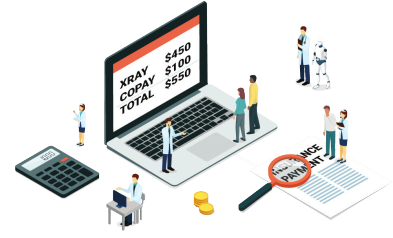As advancements in patient procedures, treatment, and diagnostic testing become more scientifically sophisticated, providers and hospitals are finding the insurance-mandated prior authorization requirements are growing as well. For care to be obtained, prior authorizations have to be identified, processed, and submitted, with follow-up and final approval secured as quickly as possible to negate possible lapses in patient care.
Today’s healthcare leaders are looking for ways to more efficiently tackle the burdensome workflow brought by prior authorizations while also increasing revenue and significantly reducing administrative costs. With the majority of hospitals and physician practices using a manual or partially manual system, we first explore the significant efficiencies to be gained by employing advanced prior authorization technology solutions.
Next, we look to the future and delve into the potential for massive growth in prior authorizations due to changing patient demographics and industry advancements and then explore where systemic change is being initiated that will reduce prior authorization demand. Coupled with the simultaneous growth of electronic advancements, prior authorizations can become a manageable tool as it was originally intended.

The Manual Process for Prior Authorizations
When a patient is seen and their treatment plan calls for a new or complex procedure, advanced diagnostic test, medication, or piece of durable equipment, most insurance payers require a prior authorization approval to be obtained before care can begin. While each payer has company-specific requirements, the basic process includes the following:
- The patient is seen and a care plan is developed. The provider, in each case, must document the visit and specify the medical necessity that dictates the prescribed procedure, diagnostic test, medication, or durable medical equipment.
- Clinical and business office staff then work together to identify if a prior authorization is required based on information available from the insurance plan. This often requires volumes of handbooks, updates, and reams of forms organized by specific payers.
- If a prior authorization is required, the correct form for the specific request will be filled out and submitted to the appropriate insurance payer through fax or insurance portal.
- The insurance payer will then either approve the request or reject it pending further information, i.e., missing documentation on medical necessity, missing patient demographic information, patient not covered by the plan.
- If the request is approved the patient’s care can continue. If it’s rejected, the practice or hospital department is obligated to submit corrected information or change the diagnosis and patient care plan (unless the patient opts to pay out of pocket for the full cost of the procedure). Follow-up is done by phone and fax machine.
- If a request is rejected outright, a provider can request an appeal which is most often handled by a third-party vendor that is interjected to review the approval request and determine the final resolution.

When Technology is Introduced to the Prior Authorization Process
By automating prior authorizations, we can streamline that same process outlined above so that patients can obtain the necessary care, while providers and hospitals experience less frustration and a significant reduction in operating costs and claim denials:
- Initial Processing — From the moment patient information is entered into the EHR/EMR system, guided processes monitor for the key identifiers to initiate prior authorization approval. Electronically matching procedures, ordered tests, durable medical equipment, or medications with constantly updating insurance requirements, the system stands ready to gather the required information and submit the request in real-time once a candidate is identified. Business and clinical staff no longer have to manually process forms, wait on hold, or fax repeatedly and are able to refocus their time on higher-level functions.
- Continual Follow-Up — Once the prior authorization approval has been submitted, electronic follow-up occurs 24/7 until a final resolution is obtained. If additional information is required or an appeal is necessary, the practice is notified immediately so that a response can be crafted and submitted as soon as possible.
- Dashboard Notifications — Waiting for insurance payer responses has historically been a time-consuming affair that took hours of follow-up and burdensome administrative effort. With an interactive dashboard, today’s electronic software gives a practice snapshot clarity on all active requests so that patient and clinician questions can be answered immediately and follow-up can occur as necessary.
- Scheduling — Alleviating the frustrations of having to schedule and reschedule patients based on prior authorizations, a hospital or practice would have much more accurate parameters to allow and a much more efficient process for everyone improving the patient’s experience and allowing the providers to focus on their care.
- A/R and Claims Management — With fewer prior authorization problems comes fewer rejected or denied claims, possibly up to 31% fewer according to the MGMA,1 and more revenue hitting the bottom line. And as an added bonus, AI-assisted software exists that handles denied claims in a manner similar to the prior authorization solution with a >95% quality standard.
- Analytics and Reporting — Bringing full transparency to future operations, timely analytics, and reporting pinpoint any breakdowns in efficiency or areas needing improvement so that future patients benefit from an even better experience.
Prior Authorization Technology and Artificial Intelligence
We hear a lot about Artificial Intelligence (AI) these days and what it means to solve our most frustrating problems like reducing manual, time-consuming, and repetitive tasks or removing human error from the prior authorization equation?
The growing use of AI in the healthcare industry brings new and exacting ways to support the clinical decision process as exampled by:
- Advanced identification in imaging studies2 for radiology
- Surgical robotics in specialties like cardiology and orthopedics
- Sleep apnea detection in sleep medicine
- Analyzing bacterial colony morphology in laboratory testing3

Simultaneously, AI is being introduced into the healthcare business lifecycle through patient access and revenue cycle management (RCM) to enhance collectible revenue, reduce claim denials and rejections, and bring far less burdensome administrative workflows. The ultimate winner in this evolution is undoubtedly the patient experience.
An AI Primer for Business Applications
Explaining the detailed logistics of how AI works can be formidable, however, this clarification is suitable for our purposes: utilizing a predefined set of algorithms, AI-assisted software uses statistical analysis to unlock data insights. It then supports data-driven decisions that improve the timeliness and accuracy of targeted outcomes. AI programming can combine large chunks of data through iterative processing allowing the software to “learn” by memorizing patterns in the data.4
To illustrate through the lens of prior authorizations, AI-driven prior authorization software would be integrated bi-directionally with a practice or hospital’s EHR/EMR and billing system used for client management through cloud-based technology.
As a patient’s order arrives, procedures, tests, medicaments, or equipment requiring prior authorizations would be electronically identified, provider/facility detail, patient demographics, and test/diagnosis information would be collected, and an approval request submitted in real-time to the insurance payer through highly secure cloud technology.
Managing Constantly Changing Payer Information with AI
To determine the prior authorization parameters and route the request to the appropriate insurance payer portal, a manual system would require constant updating to stay ahead of the insurance changes. On the other hand, technology with machine learning capabilities would access continually updated insurance information clearinghouses storing thousands of insurance groups and plans, each with up-to-date unique guidelines and requirements.
When using AI-driven software, a pre-defined set of algorithms uses statistical analysis to unlock data insights and then supports data-driven decisions that improve the timeliness and accuracy of targeted outcomes. AI programming can combine large chunks of data through iterative processing, enabling the software to ‘learn’ by memorizing patterns in the data.

Hospitals and practices, challenged to obtain prior authorizations for their services, can use cloud-based Al-driven software that is integrated bidirectionally, using a facility’s information system for client management. Prior authorization approvals that once took several hours to several days or weeks can now be initiated in real-time with a 98+% accuracy rate.5
Offering a Comprehensive and Secure Cloud-Based Solution
Using, as an example, Infinx Prior Authorization Software (IPA) Platform, an AI-driven software that creates a seamless and scalable prior authorization solution using Health Level 7 (HL7) or Application Program Interface (API) based integration and is compatible with all leading EHR/EMR, Billing, RIS, and LIS systems. The IPA Platform embeds all Patient Health Information (PHI) in layers of security that is Electronic Data Interchange (EDI) compliant and stores the data on the cloud using 64-bit and 256-bit encryption that guarantees 100% HIPAA compliance.6
Streamlined Follow-Up, Appeals, and Changes
No longer relying on manual workflow, prior authorizations can be tracked using real-time analytics, followed up electronically 24/7, with the status continually updated on an interactive dashboard. This eliminates the need for personnel to spend countless hours on hold or faxing information to the myriad insurance payers, each with their own set of guidelines.
When unexpected changes are reported, including procedure level, service level, or demographics, the information is critical to the prior authorization process. With an AI-enhanced solution, unexpected changes can be accommodated and retransmitted in real-time directly to the impacted insurance payer without delay.
AI Doesn’t Work in a Vacuum – Requires Support from Human Intelligence

By themselves, automation and AI-driven software are capable of amazing things. However, to have a truly comprehensive prior authorization process, one must have a support team of highly trained specialists available to supplement with human intelligence and problem-solving skills. When faced with requests for clinical documentation, emergency or semi-emergent care requests, or other outliers, a blended system like our prior authorization software will use a team of trained specialists to ensure complete coverage for the entire prior authorization process.
With Technology Comes Increased Revenue
The prior authorization process is the least appreciated function in any hospital, practice, or facility. It is rightfully seen as disruptive to the patient’s care and experience, a roadblock to necessary procedures and equipment, and uncompensated use of physician and staff time.
Now, more than ever, healthcare is under unrelenting financial pressure — from changes to payment models and fee schedules to ever-reducing reimbursement structures, revenue is, at best, holding steady or, at worst, steadily falling industry-wide. With a future that promises improving healthcare outcomes reliant on more and better diagnostic tools and improved medical procedures and techniques, everyone is finding themselves in a financial vice grip that’s only going to get worse.
One way to make a substantial impact is to use automation and AI to accelerate the prior authorization approvals. With automated prior authorizations, the opportunity to positively impact revenue is four-fold:
- Stop patient migration or outright abandonment of care through quickly completed prior authorizations that allow immediate scheduling and care progression
- Improve utilization of providers’ time and resources
- Reduce claim denials and rejections by as much as 80%
- Redirect staff costs to higher-value functions including improving the patient’s overall experience and retention
The 2020 CAQH Index, a widely-respected bellwether, recently released estimates that the current cost to process a prior authorization is estimated to be $13.40 (manual) vs. $1.93 (electronic) at a potential industry-wide savings of $11.47 for each occurrence.7 While their methodology uses a lot of variables, like salary costs, insurance company variants, and procedure/test mix that can vary from region to region, the cost savings are significant and worth consideration.
The Time is Now for Systemic Reform
Shifting the conversation to the impact prior authorization has had on the entire healthcare system over the years, it becomes even more impactful to see how advanced automation’s time is now.
Undoubtedly, prior authorization requirements will grow as we move into the future based on the explosive growth of new healthcare technologies for diagnosis and treatment. With hospitals and practices already bending under the weight of current prior authorization volume, the industry simply can’t absorb even more to be processed and managed manually.
Maximizing efficiency through streamlined technology is the best solution long term.
Two Systemic Changes Increasing Prior Authorizations
1. High Tech Diagnosis and Treatment Options Grow
While traditional diagnostic, treatment, and care delivery techniques have been the foundation of clinical practice, every specialty of medicine is presented with new and technologically advanced opportunities that raise the bar on their ability to provide state-of-the-art care.
As an example, molecular and genetic diagnostics in laboratory testing are becoming rising stars with new and better tests developed every day. Today, molecular and genetic testing is responsible for an estimated $8.7 billion in laboratory revenue and is expected to grow to $12.9 billion by 2024.8
Growing at a similar pace is the field of advanced imaging, including studies utilizing CT and PET scans, nuclear medicine, and MRIs, that continues to expand in use. Their importance as diagnostic tools is ever-expanding and considered an essential “standard of care” in a growing number of situations.
2. An Aging Population Transforms the Procedure Mix Industry-Wide
In addition to the expanding repertoire of advanced testing and procedures brought about by forwarding leaps in technology, our population is healthier and living longer than at any other time in history. With this comes an increase to age-related deterioration issues such as osteoarthritis that impacts orthopedic replacement procedures, including knee and hip replacement surgery and the related rehabilitation, age-related cardiovascular disease, sleep apnea, and sleep-related disorders, and cancer propensities that increase with age, i.e., colon, breast, prostate.9
A Growing Reimbursement Dilemma
This creates a healthcare reimbursement conundrum that is growing exponentially unmanageable. Providers, seeking to improve patient care and outcomes, are finding more opportunities to use advanced testing in their diagnostic process, and face a patient base needing more age-related care. This, in turn, creates growing problems for insurance payers who are trying to contain costs and ensure medically sound and appropriate patient care is being delivered.
To balance the expanding diagnostic testing choices and advanced procedure options with existing levels of contractual obligation, insurance payers are using prior authorizations as a way to manage physician behaviors and patient expectations. With younger clinicians entering the system that will want increasingly advanced diagnostics and treatment options, the use of prior authorizations is becoming more, not less, prevalent.

Industry-Wide Pressure to Reform Prior Authorizations
Healthcare providers, whether hospital or practice-based, continue to experience the administrative burdens placed on them by increasing prior authorization obligations. In the macro sense, the industry continues to absorb an aging population that’s living longer and requires more care, the increasing use of High Deductible Healthcare Plans (HDHP) that transfer additional costs to patients,10 and the perpetual decline in reimbursement due to, among other things, the Protecting Access to Medicare Act of 2014 (PAMA).11
Originally conceived and developed as a utilization review technique in the last century, prior authorization mandates issued by insurance payers have evolved into a time-consuming administrative burden that negatively impacts revenue for hospitals and providers system-wide. Creating adverse consequences throughout healthcare, far-reaching implications are detailed in the American Medical Association’s (AMA) 2019 Prior Authorization Physician Survey where 91% of respondents reported care delays and 28% said that the often delayed process led to serious adverse events for patients (i.e., death, hospitalization, or a life-threatening event).12
How Prior Authorization Inefficiencies Specifically Affect Hospitals and Practices
Across the spectrum, hospitals and practices of all specialties manage their prior authorization function by responding to the latest insurance payer mandate. By employing higher-level technology, they approach the future from a more proactive stance.
An Outsized Pain Point for Hospitals and Practices
With an estimated 182 million prior authorization transactions processed per year according to the Medical Group Management Association (MGMA),13 it is easy to see where issues are bound to arise related to sheer volume. With that in mind, this fact seems almost inconceivable: prior authorizations are the least automated business function in most practices. While verifying insurance and filing claims is done electronically in many, if not most hospitals, practices, and ancillary or outpatient departments, only 21% of business departments use a fully automated prior authorization solution.14
With significant reform campaigns proposed or underway through the American Medical Association 15 and Congress,16,17 little change has been forthcoming, and 79% of participants industry-wide 18 are still manually processing prior authorizations using labor-intensive methods (i.e., phone and fax) that require several hours to several weeks to complete.19
Hospitals and Specific Specialties Getting Results
Taking a look at specific groups within the industry, we find many similarities but with customized solutions each can meet the challenge. Here are some real-life examples detailed by specialty.
Hospitals
For outpatient departments, ambulatory surgery centers, and physicians working in a hospitalist capacity, prior authorizations are typically handled by the hospital finance and billing department where a team of employees manually processes the paperwork or within each department as determined by protocol.
While any procedure or test ordered by a physician needs that provider to manage the prior authorization process, that still leaves a multitude of required prior auths to ensure adequate reimbursement, especially for Medicare patients.
By automating the prior authorization function within the hospital or related hospital-based out-patient facilities, revenue can be captured that might otherwise be lost. This can greatly impact the bottom line in a time when hospitals are operating on the thinnest of margins.
As evidenced by this case study, one of the largest and most respected hospitals in the country struggled with perpetually backlogged prior authorizations. The problem caused them to endlessly reschedule or turn away patients resulting in lost revenue and underutilized equipment.
By automating their prior authorization process, they were able to get ahead of their revenue cycle problem and quickly authorize and confirm every procedure. This seamless integration led to an overall 95% successful authorization rate, plus 99% error-free audits with 100% compliance to HIPAA Standards.
Read more about hospital-specific prior authorizations in our white paper here.
Radiology & Imaging Centers
For radiology practices and imaging centers, prior authorizations continue to expand as providers use advanced diagnostic testing to isolate, diagnose, and treat complex medical problems. Specifically, CTs, PETs, MRIs, and Nuclear Medicine procedures require insurance approval before a patient can be seen.
While the ordering providers are responsible for obtaining the prior authorizations before the patient is sent to a specialty provider, like radiology, it often falls to the specialist’s practice to complete the process on behalf of the patient so that they can initiate testing or treatment.
Automated prior authorizations expedited the process through cloud-based software that allowed approval and follow up supported by certified technicians.
Here’s a brief summary of a case study showing how we helped a radiology group with their prior authorization workflow.
A highly successful outpatient radiology group with a large medical imaging center specializing in full major modality scans, specifically CT, PET, MRI, and Nuclear Medicine, was experiencing an overwhelming volume of prior authorization demands from referring providers (>70%). Once they implemented a scalable solution offering total automation of the prior authorization workflow, an intuitive interface with cloud-based access, and expedited support for emergent requests they recognized the following improvements:
- Faster turnaround time for prior authorizations and expedited scheduling
- Increased revenue by $750-$1,000 per day
- Reduced patient migration with more competitive prior authorizations by 30% per day
- Significantly reduced manual tasks and administrative time
- Strengthened relations with referring providers and practices
For more radiology-specific discussion on prior authorizations, check out our radiology patient access white paper here.
Orthopedics
As a surgery-focused specialty, orthopedics must obtain prior authorization on many patient procedures, both required and elective, not to mention if they perform advanced radiology testing in the group/facility. As the population continues to age and there are more and more active seniors opting for elective joint replacement surgeries, prior authorizations are sure to grow in number. What is now a difficult and burdensome system being handled manually in most cases, promises to become overwhelming unless streamlined and automated.
As demonstrated in the following case summary, by bringing electronic prior authorizations into the mix, these orthopedists were able to position for the future onslaught of insurance demands.
A large East Coast Orthopedic Group with 70 providers at 11 locations providing orthopedic services, as well as imaging, rehabilitative, and primary care services, faced a growing backlog that hampered patient access and stymied throughput, the average prior authorization took 11 days and resulted in frustrated physicians and patients.
By leveraging an AI-driven solution to automate and standardize the prior authorization task, their process became more reliable saving over 80 hours per week of staff time, the equivalent of $70K+ annually, with increased accuracy.
To learn more about orthopedic-specific prior authorizations, check out our white paper.
Cardiology
Echocardiograms and stress echocardiograms, unless performed emergently, and many cardiology procedures and surgeries, including diagnostic and interventional procedures such as diagnostic catheterizations and electrophysiology impact procedures, require prior authorization. Without a doubt, many practices are struggling with the sheer volume of work these manual preauths take to complete and would benefit from pursuing upgraded technology to make that happen.
As discussed in the following case study, automating the prior authorization process reduces workflow, as well as denials and rejections, and increases patient and provider satisfaction while improving the bottom line.
A large multi-facility cardiology practice with over 50 providers in Central Texas, specializing in advanced cardiology and electrophysiology, was experiencing an overwhelming volume of claim denials and rejections. Upon investigation, it was quickly determined that over 80% of the denied claims were due to missing or incomplete PAs.
By automating their previously manual prior authorization system, they achieved the following results
- A streamlined and automated system that returned completed prior authorization in real-time
- Reduced rework and follow-up on missing prior authorizations and significantly decreased denials and rejections received from insurance payers
- The overall project improved quarterly collections by over $1M during the first two quarters
For more discussion on cardiology-related prior authorizations, check out our white paper here.
Laboratory
With genetic and molecular testing becoming more and more the standard of care in the community, laboratories are faced with the ongoing dilemma of how to handle their huge (and growing) volume of prior authorizations? Before or after the fact, labs struggle with using a manual system that is time consuming and inefficient while also delaying care for patients.
Looking to the experience of the lab referenced in the following case study, by effectively automating prior authorizations employee effort is shifted to patient care, accuracy improves, and rework is vastly reduced.
A large west coast clinical laboratory began ramping up their prenatal and carrier screenings program for female patients during their ninth week of pregnancy. The lab was searching for a way to effectively expand its prior authorization program.
By automating their previously manual prior authorization system, they were able to achieve the following results:
- An automated system that was scalable and highly accurate
- Quadrupled preauth volume
- Improved overall prior authorization accuracy rate from 65% to 98%
- 100% compliance with all payer guidelines and protocols
Find out more about laboratory-related prior authorizations by reading our white paper here.
Pain Medicine
Prior authorizations in pain medicine often come down to what medications or procedures are prescribed, i.e., long-acting opioids, advanced imaging testing, or in-patient treatment programs. The volume can strain resources and directly affect patient outcomes.
With any comprehensive pain management program, comes the need for prior authorizations and due to the nature of patients experiencing severe, debilitating pain, time is of the essence. By implementing prior authorization technology that streamlines the process where the provider can have answers in minutes instead of hours or days, patients can receive the relief that they need much more timely.
For more information on prior authorization solutions in pain medicine, check out our white paper here.
Sleep Medicine
While the field of sleep medicine is expanding to meet the needs of an aging population, so are the requirements for prior authorization for therapy, testing, and supplies, including:
- Polysomnography; sleep staging, and staging with the initiation of continuous positive airway pressure therapy (CPAP) or bilevel ventilation when attended by a technologist
- Home sleep apnea testing
- Use of durable medical equipment, including respiratory assist devices, bi-level pressure machines, and humidifier equipment and components
Without timely and accurate prior authorizations, these services are at risk of being denied and the patient being responsible at 100%. By incorporating advanced automation into the prior authorization workflow, sleep medicine providers can ensure revenue earned is revenue collected while also improve the patient’s experience.
To learn more about sleep medicine prior authorizations, read our white paper on here.
Physical Therapy and Occupational Therapy
Physical Therapists and Occupational Therapists (PT and OT) not only deal with prior authorizations for regimes of care, but also durable medical equipment, prosthetics, orthotics, and supplies (DMEPOS). In fact, it seems that most insurance payers have a master list of DMEPOS, including power mobility devices, that trigger a preauth requirement – in particular, back braces (HCPCS Code L0650).
PT and OT providers also have to work with ordering providers to ensure that their choice of codes matches with anything submitted by the referring doctor, often on care that hasn’t taken place yet. By using AI-driven software with a dashboard that allows easy administration when communicating between healthcare providers, patient care is facilitated and PT and OT practices maintain their crucial relations with their referring base.
Find out more about physical therapy and occupational therapy prior authorization workflow optimizations by reading our white paper here.
What the Future Holds
One’s imagination is the only limit for the future of AI in healthcare. Certainly, in the near term, AI-supported functionality in the healthcare billing lifecycle will evolve into a richer and more comprehensive ability to evaluate clinical details to ensure medical necessity for prior authorizations before they are submitted for approval.
Further improving the patient experience will be advances in the patient access area with improvements that will facilitate scheduling and managing the patient’s propensity to pay. As well, AI is supportive in the new Clinical Decision Support Mechanism (CDSM) process that impacts not only radiologists but also any primary or specialty care providers that order advanced imaging procedures for Medicare patients
In fact, recognizing the challenges brought by the new CDSM, the Centers for Medicare and Medicaid Services (CMS) extended the mandatory implementation date to January 1, 2022. This extension is intended to give both ordering and furnishing providers ample time to negotiate the technological and workflow challenges before there is a monetary impact.
In addition to optimizing the A/R process through denials management, AI-assisted processes are critical to the new insurance discovery software being used to identify the coverage that patients have not communicated to providers for various reasons (emergency admissions, charity care, etc.).20
In Summary
Taking the macro view, we see an industry in flux and under the most stringent constraints in reimbursement reduction, increasing paperwork, and administrative headaches. This is causing industry-wide clinician and provider burnout at unprecedented rates.21 By continuing to create an unsatisfying environment, coupled with rising population growth and an increasing number of seniors seeking care, we’re projected to experience an estimated 120,000 physician shortfall by 2030.22
To date, legislative relief has not produced any tangible results in combating the prior authorization problem. Simultaneously, numerous healthcare-related entities (including some insurance payer associations) have thrown their collective weight at the problem and have been rebuked.
A more proactive stance would be to embrace the paradigm-shifting technology of automation and AI-driven software. Coupled with highly trained specialists for outliers, hospitals, providers, and groups can recognize substantial cost savings through decreasing workloads, significantly reducing denials and AR rework, and improved revenue capture
To learn more about opportunities to improve prior authorization efficiencies using AI and automation, supported by experienced prior authorization specialists, schedule a demo today.
Do you or your staff spend too much time processing prior authorizations? Our Essential Guide to Prior Authorization Technology takes you through all the ways you can improve your prior authorization workflow for your practice or department.
Download a PDF version of the guide “The Essential Guide to Prior Authorization Technology” to read later. Or, if you’re ready to dive in, continue reading below.